Getting to know the eight-core representative of the Ryzen 9000 family, the Ryzen 7 9700X processor, turned out to be a disappointment. Despite the fact that AMD significantly strengthened the Zen 5 architecture, improving its IPC rating by 16%, this eight-core processor turned out to be almost no faster than its predecessor. Much of the gain in specific performance was offset by lower clock speeds and a limited bandwidth DDR5 memory controller, resulting in an average advantage of only about 5% for the Ryzen 7 9700X over the Ryzen 7 7700X in applications and games. You can read more about the situation with the Ryzen 7 9700X in a separate review – it clearly shows why the new eight-core processor turned out to be such an unsuccessful solution with an inflated price.
But does this mean that all other members of the Ryzen 9000 family are not worth considering? Not at all. For example, the flagship model in this family is devoid of at least one of the main disadvantages of the Ryzen 7 9700X – its clock speeds look almost no worse than those of a similar processor of the previous generation. For this alone, the 16-core Ryzen 9 9950X deserves to be awarded its own review, because it has all the makings to correct the first impression of desktop Zen 5.
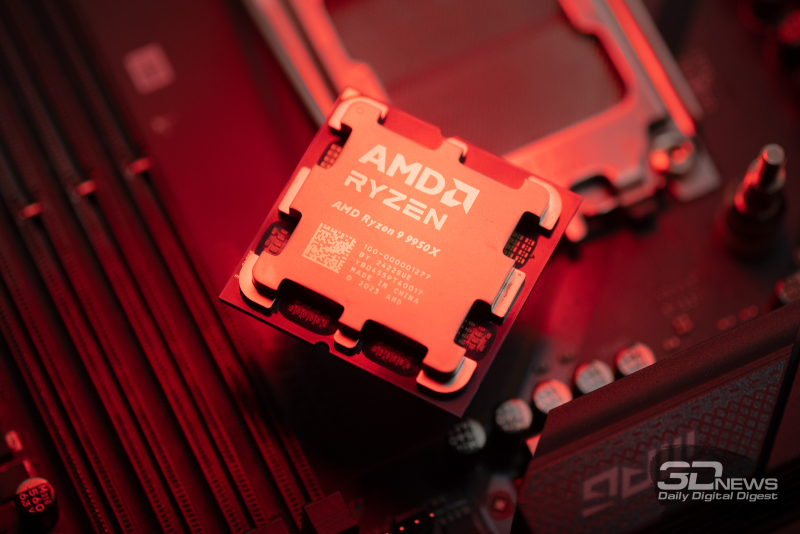
In addition, the Ryzen 9 9950X, like any other AMD processor with 16 cores, is very different from the eight-core Ryzen 7 9700X in design, and in this case it is incorrect to generalize conclusions about them, referring to the unity of the architecture. The older Ryzens are assembled from two eight-core CCD (Core Complex Die) semiconductor crystals, and this gives them a certain specificity. In particular, their L3 cache consists of two independent halves, and interaction between cores located in different CCD crystals is associated with certain difficulties. Previously, this was considered an innate and incorrigible feature of AMD multi-core processors, but in the new generation of Ryzen, the company’s engineers resorted to certain software tricks in order to try to smooth out the shortcomings of the dual-chip design. As a result, the Ryzen 9 9950X differs from the Ryzen 9 7950X not only in architecture and frequencies. There is another layer of changes at the level of driver support, and this is another interesting topic that cannot be ignored.
⇡#Ryzen 9 9950X Details: Zen 5 and Downclocking
Currently, the Ryzen 9000 processor lineup, codenamed Granite Ridge, includes four processors with the traditional AMD number of cores from 6 to 16. The model discussed in this review, the 16-core Ryzen 9 9950X, takes the place of the flagship in the family .
In addition to the number of computing cores, frequencies and price, the Ryzen 9 9950X (like the Ryzen 9 9900X) differs from younger models in the number of CCD chiplets (complexes of cores) codenamed Eldora used in it. By analogy with processors of previous generations, each such chiplet in the Ryzen 9000 series contains eight Zen 5 cores and a shared 32 MB L3 cache, so there are two of them installed inside the Ryzen 9 9950X. The corresponding silicon crystals are produced using the 4nm N4P process at TSMC facilities, which can be considered a step forward compared to their predecessors, the base chiplets for which are produced using 5nm standards. Thanks to a more modern process technology, AMD was able to fit 8.6 billion transistors into the 70.6 mm2 Eldora die. The transistor budget increased by about 27%, and due to this, numerous architectural advantages of Zen 5 were realized: improved branch prediction, increased L1 cache, expanded execution domain, faster data processing, full support for AVX-512, etc.
At the same time, the IOD chip included in the Ryzen 9 9950X is inherited from the Ryzen 7000. It is exactly the same 6-nm crystal with an area of 122 mm2 with a dual-channel DDR5 controller (with official support for DDR5-5600), a built-in graphics core based on RDNA3 architecture ( based on two CUs) and a PCIe 5.0 controller with 28 lanes.
Despite more modern production technology and equality with the Ryzen 9 7950X in terms of the number of cores and threads, the base frequency of the Ryzen 9 9950X has decreased by 200 MHz and is 4.3 GHz instead of 4.5 GHz. But the maximum frequency, as before, is formally capable of reaching 5.7 GHz. Also, the Ryzen 9 9950X has an L3 cache with a total capacity of 64 MB, an L2 cache with a capacity of 1 MB per core and is limited by a thermal package of 170 W – in these numerical parameters there are no differences from the Ryzen 9 7950X. Moreover, the new 16-core, like all its other brothers, is designed for use in the Socket AM5 platform and, after updating the BIOS, is fully compatible with commercially available motherboards based on the X670 and B650 chipsets.
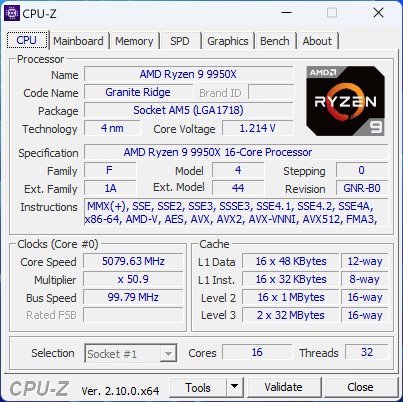
At first glance, the specifications of the Ryzen 9 9950X and Ryzen 9 7950X seem very similar, but in reality their frequencies diverge more than you might expect. We ran a traditional clock measurement in Cinebench R23 with a different number of active threads capped and came up with a picture that’s broadly similar to what we’ve already seen when comparing the Ryzen 7 9700X to the Ryzen 7 7700X.
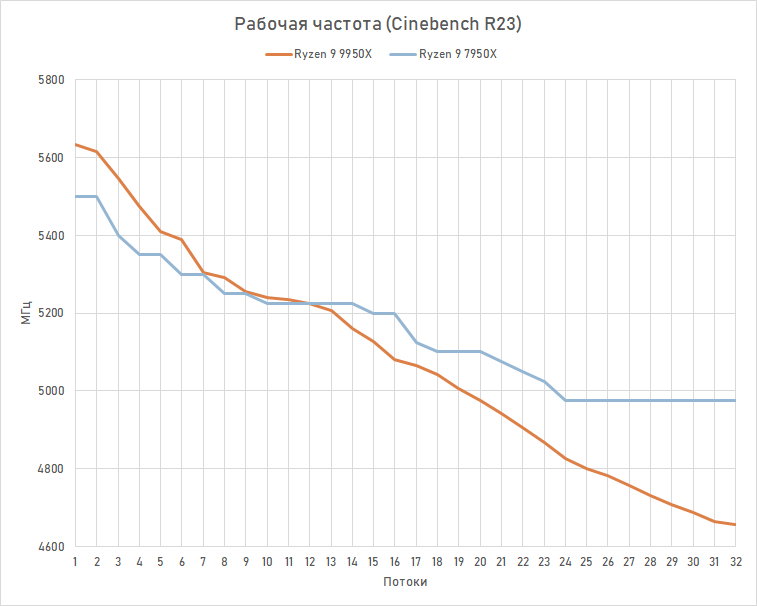
With a low-threaded load, the Ryzen 9 9950X exceeds the Ryzen 9 7950X in clock frequency by 100-150 MHz, although formally the maximum frequency of both processors is the same. The advantage of the new 16-core processor persists up to a 12-thread load, after which it begins to give way to its predecessor, eventually pushing it ahead by 300-350 MHz. Thus, while the frequency of the Ryzen 9 7950X with 32-thread rendering is in the vicinity of 5 GHz, the Ryzen 9 9950X in the same conditions drops to work at a frequency of 4.65 GHz.
This happens for a rather unexpected reason. Despite the lack of difference in thermal packages, the manufacturer has set a more conservative consumption limit for the Ryzen 9 9950X – the PPT (Package Power Tracking) value. For the AMD processors we’ve dealt with previously, it was almost always related to TDP with the ratio PPT = TDP ∙ 1.35. So, based on this formula, the PPT limit for the 170-W 16-core Ryzen 9 7950X is set to 230 W. The same consumption limit would be logical for the Ryzen 9 9950X, but in it AMD used a ratio with a different coefficient. As a result, the maximum power consumption of the new 16-core processor turned out to be limited to 200 W, and it is this that determines its frequency ceiling. In resource-intensive tasks that load all cores, the consumption of the Ryzen 9 9950X rests on this limit, which leads to an additional reduction in frequency.
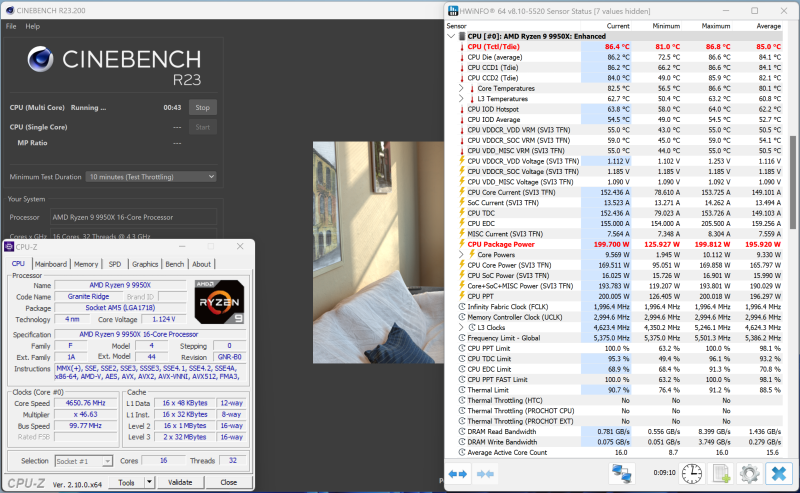
But, being configured by default, the Ryzen 9 9950X, unlike its predecessor, avoids temperature throttling – its heating does not reach the maximum permissible 95 degrees (at least with liquid cooling). And it is very likely that a more stringent PPT limitation in the 16-core new product solves precisely this problem – to make its temperatures not so traumatic for the psyche of users.
⇡#Power consumption and temperatures
Compared to the Ryzen 9 7950X, the new 16-core processor not only has a more conservative artificial consumption limit. It is also assembled on the basis of CCD chiplets, which are produced using more advanced 4nm technology. AMD explained that this helped reduce the thermal resistance of the crystal, and it became easier to remove heat from it. And this is another reason why the Ryzen 9 9950X should be cooler to operate.
Indeed, the Ryzen 9 9950X has become both more economical and cooler in comparison with the Ryzen 9 7950X. This is confirmed in all three practical scenarios that we use to estimate heat dissipation and power consumption. But the most striking illustration is multi-threaded rendering in Cinebench 2024. Under such a load, both the Ryzen 9 9950X and Ryzen 9 7950X consume around 200 W. But the new processor in this case rests on its 200-W PPT limit, warming up only to 85 degrees, while its predecessor reaches a 95-degree maximum temperature and rests there. The upper limit of consumption for the Ryzen 9 7950X is actually 230 W, but it cannot reach it due to temperature throttling.
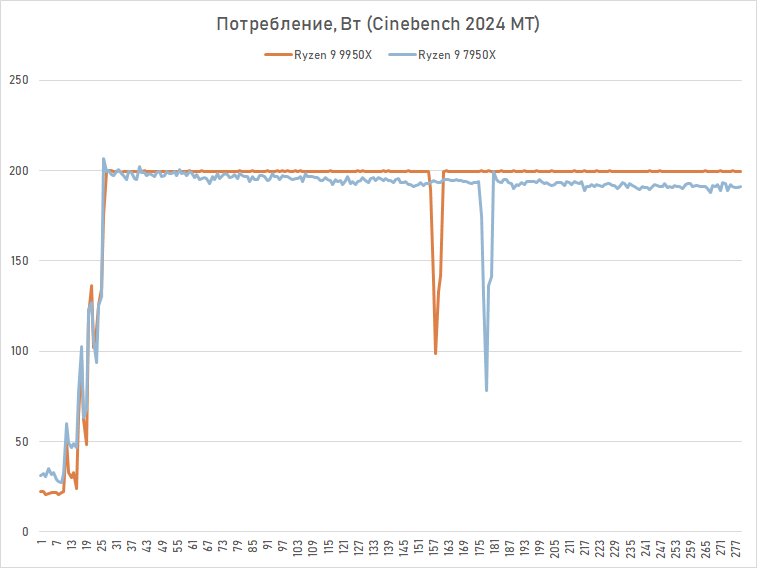
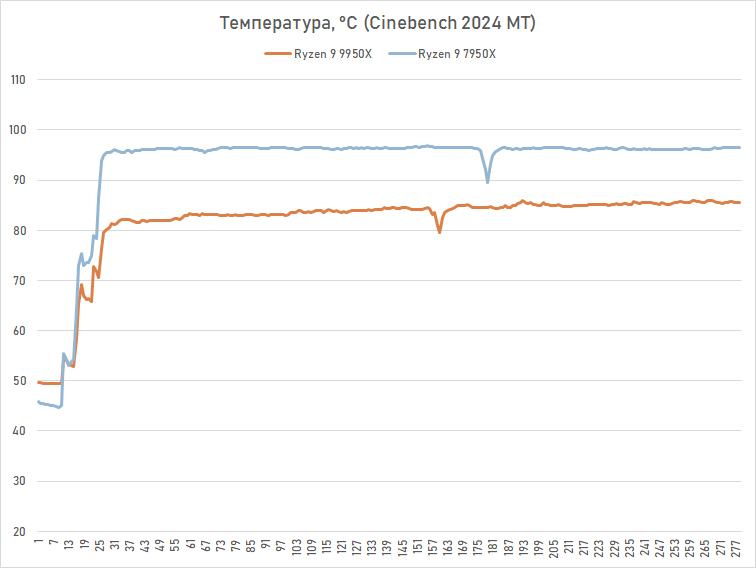
In other words, during resource-intensive loads, the consumption of the Ryzen 9 9950X and Ryzen 9 7950X is approximately the same level, but the new processor turns out to be noticeably cooler, since it is easier to remove heat from it.
In single-threaded rendering, the situation is different – the Ryzen 9 9950X noticeably outperforms the Ryzen 9 7950X not only in terms of heating intensity, but also in consumption. The energy consumption of a 16-core Zen 5-based processor is approximately 15% lower, and the temperature is almost 10 degrees lower.
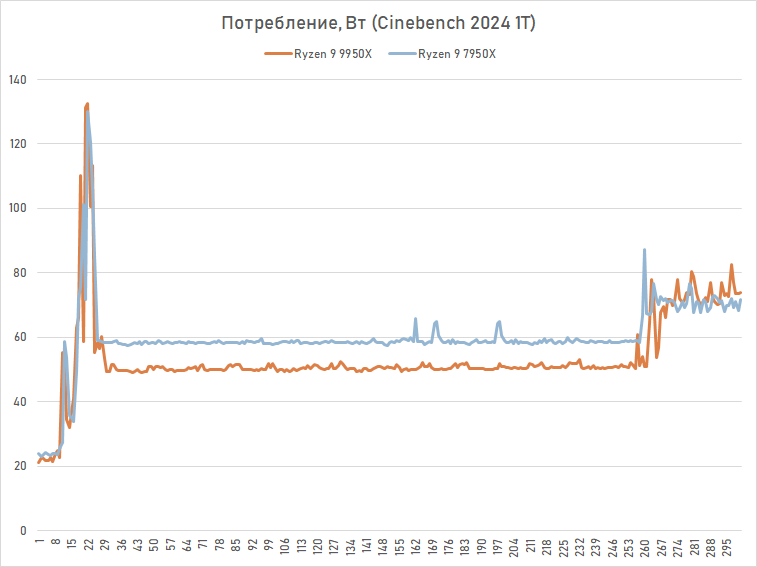
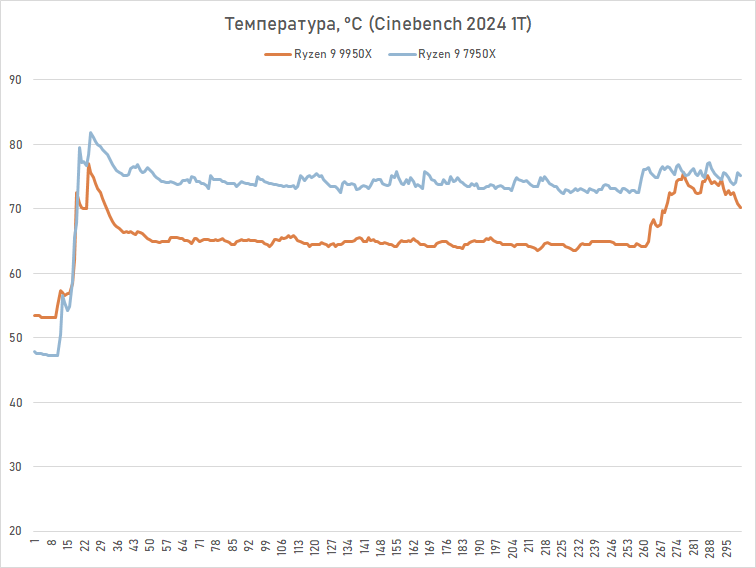
An equally clear difference between processors of different generations can be seen in Cyberpunk 2077. With the same gaming load, the Ryzen 9 9950X consumes 20 W less and remains 5-7 degrees cooler.
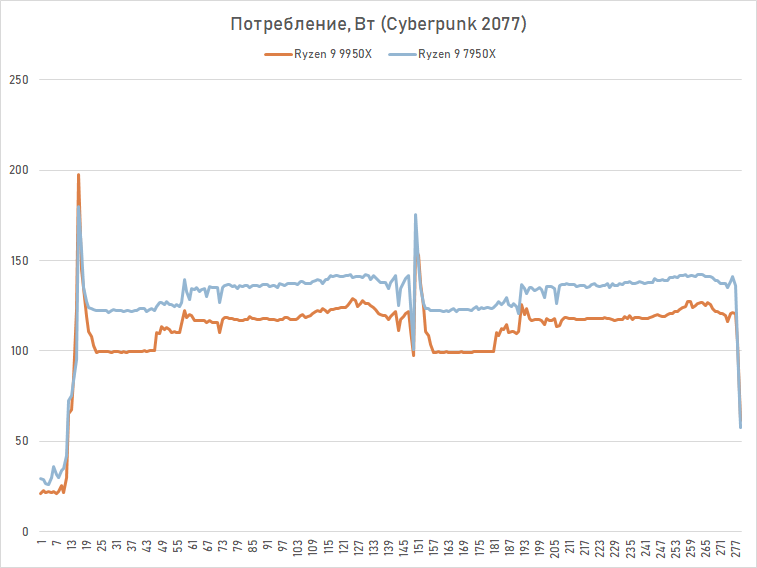
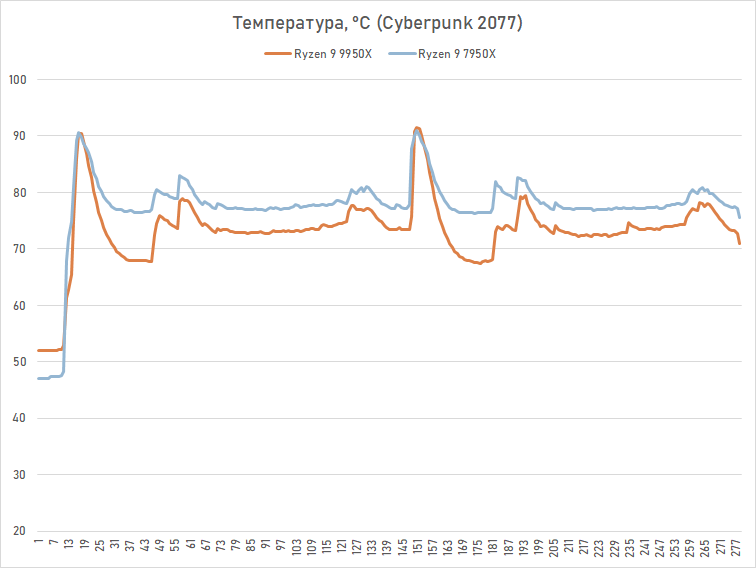
As such, the Ryzen 9 9950X’s power efficiency has definitely improved, although this is not reflected in its officially designated TDP. But more importantly, it can no longer be said about it that under any serious load it operates at its temperature limit.
⇡#Why does Ryzen 9 9950X need some kind of driver?
In addition to the Zen 5 architecture, the Ryzen 9 9950X has room for another unexpected innovation: AMD has released a special driver for this processor – PPM Provisioning. The last time we encountered a similar driver, we tested the Ryzen 9 7950X3D, the first two-chip CPU with a 3D cache, and then its need was quite understandable. It is quite difficult to say the same about the current situation.
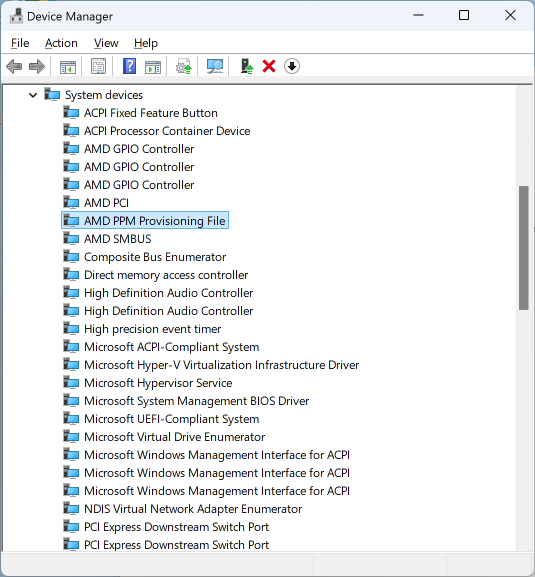
The main purpose of the PPM Provisioning driver is to force gaming loads to be isolated on the first eight cores of a 16-core processor. This is achieved by parking the second eight cores – when starting games, they are actually turned off. The expediency of this procedure in the case of the Ryzen 9 7950X3D follows from the heterogeneity of its chiplets. The L3 cache, enlarged due to the additional crystal, with a total capacity of 96 MB is provided in this processor only by the first CCD chiplet, while the second chiplet is content with a 32 MB L3 cache. Therefore, completely disabling the second chiplet and turning the processor into something like the eight-core Ryzen 7 7800X3D is a completely logical move to improve performance in games that, as a rule, do not need more than eight cores, but benefit from an increased cache size.
But why would it be necessary to turn the new Ryzen 9 9950X, which consists of the same CCD chiplets, into a quasi-octa-core? The answer to this question is provided by the results of measuring latencies when different cores operate with common data located in the L3 cache. Below is a diagram showing the delays when transferring data from one logical core to another.

It is clearly seen that the interaction between the cores of different CCD chiplets in the Ryzen 9 9950X is very difficult. If two cores of the same CCD can exchange data through a common L3 cache in 17-22 ns, then the same data exchange between cores of different CCDs causes literally orders of magnitude higher latencies – about 200 ns. Thus, AMD’s desire to avoid cases where all 16 processor cores work with the same data is quite natural. The most common scenario of this kind is games, which is why the company’s engineers decided to implement a forced shutdown of the second CCD for them in the Ryzen 9 9950X. Moreover, the scheme by which this can be implemented in practice has already been tested on the Ryzen 9 7950X3D.
It is worth mentioning that for 16-core processors of previous generations, no software crutches in the form of the PPM Provisioning driver were required, since in them the delay when transferring data between the cores of different CCD chiplets was not so blatantly high. For example, in the Ryzen 9 7950X this latency was about 75 ns, and even in the Ryzen 9 5950X it did not exceed 85 ns. In new processors, its value suddenly jumped two and a half times, and the reasons for what happened are completely incomprehensible.
Indeed, the Ryzen 9 9950X uses exactly the same implementation of the Infinity Fabric bus connecting the chiplets as the previous generation processors. Moreover, the design of the new 16-core even uses the same IOD interface chip as in the previous generation Ryzen processors. Therefore, suspicion inevitably falls on the Zen 5 architecture itself. And its guilt is indirectly confirmed by the same painfully high delays during inter-core interaction in Ryzen AI 300 mobile processors, where there are no chiplets in principle, and the Infinity Fabric bus operates at a noticeably higher frequency.
Designed to smooth out an architectural problem that had arisen out of nowhere, the PPM Provisioning driver is included in the accompanying software package for the chipset along with typical motherboard chipset drivers. However, for it to work correctly, it requires the fulfillment of a number of additional conditions. These include switching the operating system to Game Mode and using the Microsoft Game Bar utility, from which it gets information about launching gaming applications and the need to park the cores of the second CCD chiplet.
The result is a rather shaky software design that does not always work smoothly. Thus, the determination of the launch of games in the Microsoft Game Bar is based on a pre-compiled list of executable files. And all such lists cannot be exhaustive by definition. They may not include less common, old, newly released games or their pirated versions. Of course, Microsoft Game Bar has the ability to add to the list manually, but this is not always convenient.
Another issue concerns the difficulty in installing the PPM Provisioning driver correctly. AMD warns that it is not always integrated into or removed from the system correctly, so the company recommends reinstalling Windows from scratch whenever you change processors. However, checking the correct operation of the PPM Provisioning driver is quite simple – just make sure in the task manager that when launching gaming applications, half of the processor cores remain unloaded.
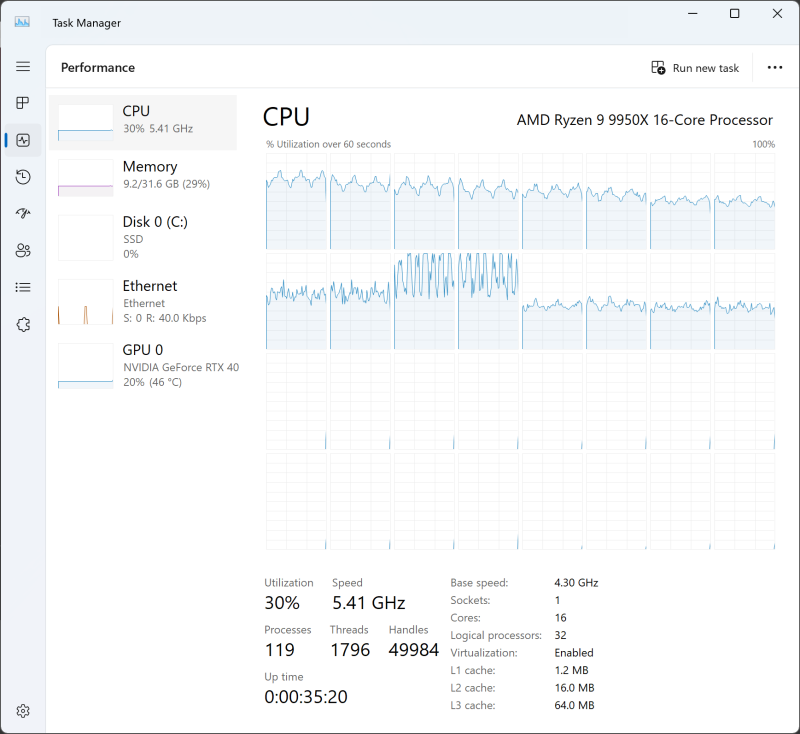
⇡#Description of the test system and testing methodology
The Ryzen 9 9950X is the flagship processor of the Ryzen 9000 series, so its set of competitors is self-evident. These are two older 16-core models with Zen 4 architecture (Ryzen 9 7950X and 3D cache-enhanced Ryzen 9 7950X3D), as well as older versions of Raptor Lake and Raptor Lake Refresh (Core i9-13900K and Core i9-14900K with 8P+ nuclear formula 16E). It is worth emphasizing that all these processors, despite differences in structure and architecture, are designed to simultaneously execute the same number of threads – 32. So, to some extent, they can be considered representatives of the same class, although one cannot fail to mention the significant difference in price. The Ryzen 9 9950X on the global market costs about $75 more than the Ryzen 9 7950X3D and Core i9-14900K, while the Ryzen 9 7950X and Core i9-13900K can be purchased for $150 cheaper than the new product.
Ultimately, the test systems included the following list of equipment:
-
- AMD Ryzen 9 9950X (Granite Ridge, 16 cores, 4.3-5.7 GHz, 64 MB L3);
- AMD Ryzen 9 7950X3D (Raphael, 16 cores, 4.2-5.7 GHz, 128 MB L3);
- AMD Ryzen 9 7950X (Raphael, 16 cores, 4.5-5.7 GHz, 64 MB L3);
- Intel Core i9-14900K (Raptor Lake Refresh, 8P+16E-core, 3.2-6.0/2.4-4.4 GHz, 36 MB L3);
- Intel Core i9-13900K (Raptor Lake, 8P+16E-core, 3.0-5.8/2.2-4.3 GHz, 36 MB L3).
- CPU cooler: custom liquid cooling system made from EKWB components.
-
- ASUS ROG Maximus Z790 Apex (LGA1700, Intel Z790);
- MSI MPG X670E Carbon WiFi (Socket AM5, AMD X670E).
- Memory: 2 × 16 GB DDR5-6400 SDRAM (G.Skill Ripjaws S5 F5-6400J3239G16GX2-RS5K).
- Video card: GIGABYTE GeForce RTX 4090 Gaming OC (AD102 2235/2535 MHz, 24 GB GDDR6X 21 Gbps).
- Disk subsystem: Intel SSD 760p 2 TB (SSDPEKKW020T8X1).
- Power supply: ASUS ROG-THOR-1200P (80 Plus Titanium, 1200 W).
The memory subsystems in the Socket AM5 and LGA1700 platforms were configured using the XMP profile of the selected set of modules – DDR5-6400 with timings 32-39-39-102.
Testing was performed on the Microsoft Windows 11 Pro (23H2) Build 22631.4112 operating system using the following set of drivers:
- AMD Chipset Driver 6.07.22.037;
- Intel Chipset Driver 10.1.19913.8607;
- NVIDIA GeForce 560.94 Driver.
Description of tools used to measure computing performance:
Synthetic benchmarks:
- 3DMark Professional Edition 2.29.8256 – testing in the CPU Profile 1.1 scenario in single-threaded and multi-threaded modes.
- Geekbench 6.3.0 measures single-threaded and multi-threaded CPU performance in common user scenarios, from reading email to image processing.
Tests in applications:
- 7-zip 24.08 – testing compression and decompression speed. A built-in benchmark with a dictionary size of up to 64 MB is used.
- Adobe Photoshop 2024 11.25.0 – testing performance when processing graphic images. The PugetBench for Photoshop 1.0.1 test script is used, simulating basic operations and working with the Camera Raw Filter, Lens Correction, Reduce Noise, Smart Sharpen, Field Blur, Tilt-Shift Blur, Iris Blur, Adaptive Wide Angle, Liquify filters.
- Adobe Photoshop Lightroom Classic 13.4 – testing performance when batch processing a series of images in RAW format. The PugetBench for Lightroom Classic V0.95 test script is used, simulating basic work with the library and editing, as well as import/export, Smart Preview, creating panoramas and HDR images.
- Adobe Premiere Pro 2024 24.5.0 – testing video editing performance. The PugetBench for Premiere Pro 1.0.1 test script is used, which simulates editing 4K videos in different formats, applying various effects to them, and the final rendering for YouTube.
- Blender 4.2.0 – testing the speed of final rendering on the CPU. The standard Blender Benchmark is used.
- Corona 10 — testing the speed of final rendering on CPU. The standard Corona Benchmark is used.
- DaVinci Resolve Studio 19.0 – assessment of video processing performance when encoding with various codecs, processing source files and applying effects. The PugetBench for DaVinci Resolve 1.0 test script is used.
- Microsoft Visual Studio 2022 (17.11.2) – measuring the compilation time of a large MSVC project – Blender version 4.2.0.
- Stockfish 16.1 – testing the speed of the popular chess engine. A standard benchmark with an analysis depth of 30 half-moves is used.
- SVT-AV1 2.1.0 – testing the speed of video transcoding into AV1 format. The original 4K@24FPS video is used with 10-bit color and a bitrate of 51 Mbps.
- Topaz Video AI v5.3.0 – testing performance when improving video quality using AI algorithms executed on the CPU. The original 640×360@30FPS video is upscaled using the Proteus model to a resolution of 1280×720, and the FPS rises to 60 using the Chronos Fast model.
- X264 164 r3186 – testing the speed of video transcoding into H.264/AVC format. The original 4K@24FPS video is used with 10-bit color and a bitrate of 51 Mbps.
- X265 3.6 – testing the speed of video transcoding into H.265/HEVC format. The original 4K@24FPS video is used with 10-bit color and a bitrate of 51 Mbps.
- V-Ray 6.00.01 – testing the speed of final rendering on the CPU. The standard V-Ray 5 Benchmark is used.
Games:
- Baldur’s Gate 3. Graphics settings: Vulcan, Overall Preset = Ultra.
- Cities: Skylines II. Настройки графики: Global Graphics Quality = High, Anti-aliasing Quality = Low SMAA, Volumetrics Quality Settings = Disabled, Depth of Field Quality = Disabled, Level of Detail = Low.
- Cyberpunk 2077 2.01. Graphics settings: Quick Preset = RayTracing: Medium.
- Dying Light 2 Stay Human. Graphics settings: Quality = High Quality Raytracing.
- Hitman 3. Настройки графики: Super Sampling = 1.0, Level of Detail = Ultra, Texture Quality = High, Texture Filter = Anisotropic 16x, SSAO = Ultra, Shadow Quality = Ultra, Mirrors Reflection Quality = High, SSR Quality = High, Variable Rate Shading = Quality.
- Hogwarts Legacy. Настройки графики: Global Quality Preset = Ultra, Ray Tracing Quality = Low, Anti-Aliasing Mode = TAA High.
- Marvel’s Spider-Man Remastered. Настройки графики: Preset = Very High, Ray-Traced reflection = On, Reflection Resolution = Very High, Geometry Detail = Very High, Object Range = 10, Anti-Aliasing = TAA.
- Mount & Blade II: Bannerlord. Graphics settings: Overall Preset = Very High.
- Shadow of the Tomb Raider. Настройки графики: DirectX12, Preset = Highest, Anti-Aliasing = TAA, Ray Traced Shadow Quality = Ultra.
- Starfield. Graphics settings: Graphics Preset = Ultra, Upscaling = Off.
- The Riftbreaker. Настройки графики: DirectX12, Texture Quality = High, Raytraced soft shadows = On, Ray traced shadow quality = Ultra, Raytraced ambient occlusion = On.
- The Witcher 3: Wild Hunt 4.04. Graphics settings: Graphics Preset = RT Ultra.
In all game tests, the average number of frames per second, as well as 0.01-quantile (first percentile) for FPS values are given as results. The use of 0.01-quantile instead of the minimum FPS is due to the desire to clear the results from random bursts of performance that were provoked by reasons not directly related to the operation of the main components of the platform.
⇡#Performance in synthetic tests
In our review of the Ryzen 7 9700X, we already said that the Zen 5 architecture, which has increased specific performance by 16%, apparently deserves the title of architecture with the highest IPC rating at the moment. The results of single-threaded tests of the Ryzen 9 9950X in the synthetic benchmarks 3DMark CPU Profile and Geekbench 6 confirm this thesis: the performance of the new 16-core AMD is not only 10-15% higher than that of the Ryzen 9 7950X, but also exceeds the performance of the Core i9-14900K. To be fair, we note that the Intel flagship is not lagging behind too much, but do not forget that its maximum frequency reaches 6 GHz and exceeds the frequencies available to AMD processors.


Multi-threaded tests produce less clear results. In resource-intensive workloads, the Ryzen 9 9950X is inferior in frequency to the 16-core Ryzen 9 7950X of the previous generation, and this reduces the advantage of the new processor to single-digit percentages. The superiority of the Ryzen 9 9950X over the Core i9-14900K is completely questionable: in Geekbench 6, for example, the flagship Intel processor produces a higher result.


However, one should not draw far-reaching conclusions from the diagrams presented in this section. Synthetic benchmarks do not give a complete picture of the real capabilities of processors, so let’s move on to discussing performance in resource-intensive applications.
⇡#Application Performance
If we talk about the results of the Ryzen 9 9950X superficially, then it is difficult to make any complaints about this processor. It works faster than its predecessor by an average of 8%, and its weighted average superiority over the competing Core i9-14900K reaches 22%. However, there are nuances.
Firstly, upon closer acquaintance with the test results, you will notice that the Ryzen 9 9950X is not faster than the Ryzen 9 7950X everywhere. There are tasks, such as decompression, compiling program code, or analyzing chess positions, where the new product is inferior to the 16-core Zen 4. This is the result of summing up both of the main disadvantages of the Ryzen 9 9950X – a lower clock speed at high loads and increased delays during inter-core interaction.
Secondly, a significant contribution to the growth of the average advantage of the Ryzen 9 9950X is made by Topaz Video AI, an application for improving video quality using neural networks, which is based on instructions from the AVX-512 set. In it, the gain of the new processor reaches 45%, and this is a very atypical case. If you remove Topaz Video AI from the average calculation, the advantage of the new CPU over the Ryzen 9 7950X drops to 5.5%.
Thirdly, we cannot say that the Ryzen 9 9950X is an unconditional victory over the Core i9-14900K, since the new 16-core AMD is not faster everywhere. The flagship Raptor Lake Refresh still holds the edge in Lightroom Classic, DaVinci Resolve and Visual Studio. Moreover, if we do not take into account the results in Topaz Video AI, where the Core i9-14900K fails miserably due to the lack of AVX-512 support, then the average performance gain of the Ryzen 9 9950X is not 22, but only 8.5%.
Rendering:



Video transcoding:



Photo processing:


Nonlinear video editing:


AI video processing:

Compiling program code:

Archiving and unarchiving:


Chess:

However, it is impossible to argue that the Ryzen 9 9950X is the best processor for working with digital content. The above diagrams clearly confirm that the new 16-core AMD is ideal for building workstations.
⇡#Gaming performance. 1080p tests
AMD definitely doesn’t consider the Ryzen 9 9950X’s gaming performance to be something to be proud of. In the official presentation of the family of new processors, it was not without reason that she avoided this topic. The thing is that the average increase in frame rate at 1080p resolution provided by the Ryzen 9 9950X compared to its predecessor was only 4%, which is clearly not enough to even come close to the gaming performance of Zen 4 architecture media, enhanced by 3D cache. In other words, in games the Ryzen 9 9950X is significantly worse than the previous generation Ryzen 9 7950X3D (and the Ryzen 7 7800X3D, which is even faster).
Accordingly, the Ryzen 9 9950X is unable to compete with the Core i9-14900K, falling behind it in average FPS by about 10%. Therefore, it is unwise to use the Ryzen 9 9950X for gaming builds – it is poorly suited for such applications, despite the price.

One of the reasons for the not very successful performance of the Ryzen 9 9950X in games is the greatly increased delays when sending data between chiplets. Largely because of them, there are projects where the new 16-core processor is inferior to its predecessor without a 3D cache. Unfortunately, the solution to this problem proposed by AMD – isolating gaming loads on the cores of the first chiplet with the PPM Provisioning driver – does not always help. In testing, we encountered situations where game processes leaked beyond the first CCD, which inevitably led to a decrease in FPS. For example, this happens in Starfield.












⇡#Gaming performance. Tests at 2160p












⇡#Conclusions
The Ryzen 9 9950X is already the second processor based on the Zen 5 architecture that came into our laboratory, so from the very beginning we understood in general terms what to expect from it. The main thing was to try to forget about the official slides on which AMD promised a 22% performance increase for the Ryzen 9 9950X relative to the Ryzen 9 7950X. After all, this is an outright lie. In fact, in demanding content creation applications, the new processor shows only a 6-8% improvement in performance, and the frame rate increase it provides in games (at 1080p resolution) is limited to 4-5%.
The reasons for such a slight increase in the performance of the new product are well understood. The growth in IPC achieved in the Zen 5 architecture, as in the case of the Ryzen 7 9700X, is counteracted by some regression in clock speeds, as well as an additional reason – unknown problems with the speed of inter-core communication.
In other words, the senior representative in the Ryzen 9000 series only confirms what was said in the Ryzen 7 9700X review. The new generation of processors with Zen 5 architecture is a significantly weaker step forward than the steps that AMD took before. The transition from Ryzen 7000 to Ryzen 9000 is more reminiscent of last year’s update of Intel processors, called a “refresh”, despite the fact that the Ryzen architecture was last updated two years ago – in September 2022.
However, all this does not mean that the 16-core Ryzen 9 9950X is a passable new product that does not deserve special attention. Although this processor currently costs more than any other desktop CPU, there are areas where it outperforms all other options on the market. In particular, this processor is unparalleled in the resource-intensive multi-threaded tasks associated with content creation, making it the best choice for a powerful work computer. In such applications, it not only outperforms the Ryzen 9 7950X and Ryzen 9 7950X3D, but also turns out to be better than the Core i9-14900K, which is inferior to the new product by a significant 8-10% in heavy tasks. Moreover, one cannot help but note the excellent performance of the Ryzen 9 9950X in applications that use AVX-512 instructions. In them, his advantage can look, without exaggeration, fantastic.
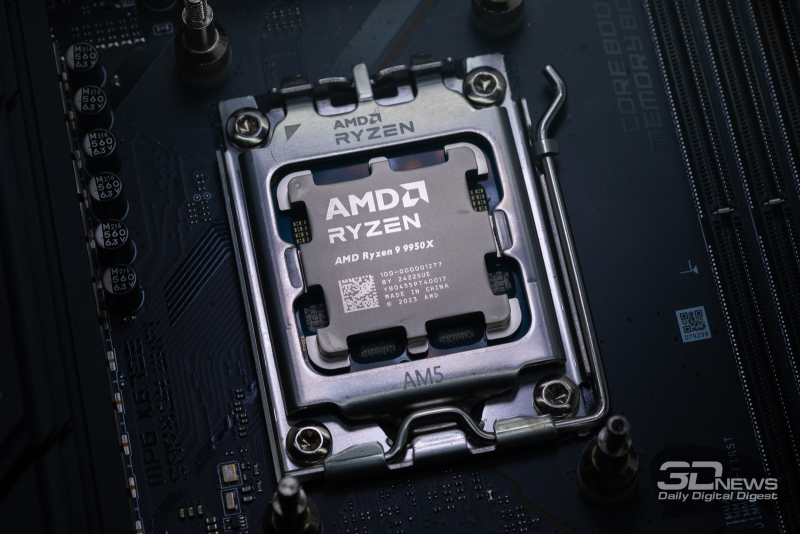
It is impossible not to note the energy efficiency of the new product. AMD has reduced the maximum consumption level of the 16-core Ryzen 9 9950X to 200 W, making it not only the most economical modern CPU with the ability to simultaneously execute 32 threads, but also the most profitable option in terms of specific performance per watt of electricity consumed.
However, the Ryzen 9 9950X is not good everywhere – just think about games. For gaming PCs, there are faster and significantly more affordable options. For example, the 16-core Ryzen 9 7950X3D, which has a 3D cache, outperforms the new product in gaming performance by 8%, and the advantage of the competing Core i9-14900K in average frame rate reaches 10% (in 1080p resolution). Moreover, the addition of the PPM Provisioning driver to the Ryzen 9 9950X, which is supposed to optimize gaming performance, was clearly not AMD’s best idea. In many cases, it makes using the Ryzen 9 9950X-based platform more difficult, plus quite often this driver simply does not provide the required result, which is why the new 16-core processor is inferior in some games to its much cheaper eight-core brother Ryzen 7 9700X.
Ultimately, all this means that the Ryzen 9 9950X is an excellent option for work systems, but gamers should clearly postpone the purchase of processors based on the Zen 5 architecture. For this audience, AMD is preparing the Ryzen 9000X3D series, but for now nothing has changed for gaming computers and the best options Core i9, Core i7 or 3D cache-enhanced Ryzen 7 7800X3D remain.